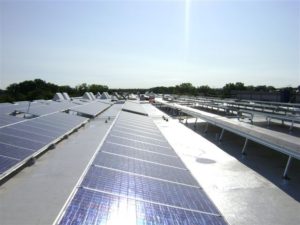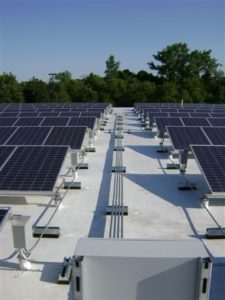Offering long-lasting and recyclable materials, Four Seasons has been recognized for our environmentally excellent practices. Beyond using responsible methods and materials, our team is here to help with additional energy-saving measures.
Learn more about how to gain energy savings through solar panels, incentives programs, utility benefits, and more.

Roofs like Duro-Last® provide excellent energy benefits that reduce necessary use of utilities like air conditioning. The Duro-Last® Cool Zone roofing system® is a “cool roof” – one with high solar reflectance and high thermal emittance. These qualities minimize the heat that comes into your building from the roof and keep your building cooler. Our cool roofs exceed California’s Title 24 requirements with 88% solar reflectance and 87% thermal emittance. By beating this stringent standard, we prove again that Duro-Last® is the world’s best roof.
Find out what perks you can get by working with a responsible roofer. For both new and existing commercial and residential buildings, there are a number of tax benefits you can qualify for with the right eco-friendly roofing system. Solar panel integration, roofing materials, insulation configurations, and heating and cooling energy savings can all get you closer to tax credits – ask us more today!
In many cases, our team of local roofers is able to maintain or even reuse existing roofing material when re-roofing or repairing your roof. This decreases the amount of waste and mess present at your job site. Customers and residents are kept happier, and the job can often be completed very quickly with material cost savings because of it.
For material we cannot reuse, we always seek to recycle or dispose of it in a responsible way. Our team of commercial roofers keeps both your business and the environment in mind with our practices, achieving benefits for both at the job site.
Four Seasons Energy Efficient Roofing recycles all possible materials – pallets, paper, Styrofoam insulation, plastic, stones from ballasted roofs, etc. from roofing projects?
Installation of an energy efficient Duro-Last® Roofing System can reduce landfill waste because over 90% of the existing roof doesn’t have to be torn off — the new roof can be overlaid?
Energy-efficient roofs are more environmentally friendly, offer significant tax rebates and utility discounts and, in many cases, pay for themselves?

Solar panels aka photovoltaics are “semi-conductor devices that convert sunlight into direct current electricity (DC).” Solar panels are usually installed as a grid type system. One of three scenarios can exist:
Solar credits and energy pricing rates are county dependent. Contact us and/or check with your particular energy company in your area on the rebates and cost incentives that exist for installation of a solar photovoltaic system.
Example of Solar Photovoltaic Savings: